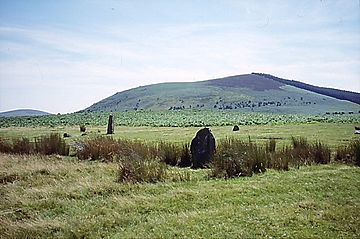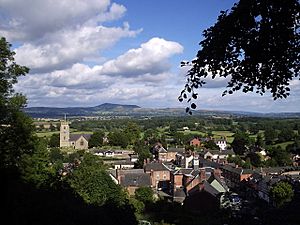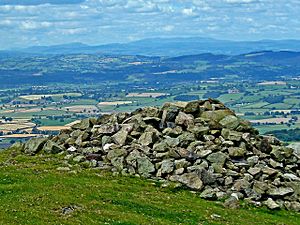Corndon Hill facts for kids
Quick facts for kids Corndon Hill |
|
|---|---|

Corndon Hill above the Mitchells Fold stone circle
|
|
| Highest point | |
| Elevation | 514 m (1,686 ft) |
| Prominence | 203 m (666 ft) |
| Parent peak | Stiperstones |
| Listing | Marilyn |
| Geography | |
| Location | Powys, Wales |
| Parent range | Shropshire Hills |
| OS grid | SO306969 |
| Topo map | OS Landranger 137 |
Corndon Hill is a well-known hill in Powys, Mid Wales. Its top reaches 514 meters (1,683 feet) above sea level.

The hill is almost completely surrounded by the English county of Shropshire. It stands out as an important landmark along the Wales-England border. The western side of Corndon Hill looks like a separate peak. Locals call it Lan Fawr, which means 'Big Hill' in Welsh.
Many people enjoy walking and hiking on Corndon Hill. There are car parks nearby, for example at Mitchell's Fold. From the top, you can see amazing views all around. The hill is also a key landmark for nearby towns like Montgomery and villages such as Church Stoke and Hyssington.
Corndon Hill is part of the Shropshire Hills. These hills are mostly to the north, east, and south. To the west, you can see the Vale of Montgomery and the River Severn. Further west, the Cambrian Mountains are visible. The Stiperstones and Shelve hills are to the north. To the east, you can spot Caer Caradoc and the Long Mynd.
Contents
Ancient Discoveries on Corndon Hill
Bronze Age Burials

Near the top of Corndon Hill, there is a large Bronze Age cairn. A cairn is a pile of stones, often built as a monument or burial site. Several other cairns are found around the summit area.
These circular stone burial mounds are common on hilltops in Wales. They were built between about 2500 BC and 700 BC. This was a time when bronze was slowly being replaced by iron for tools. These cairns usually hold one or more cremation urns. These urns often sit inside a stone box within the mound.
Mysterious Stone Circles

At the foot of Corndon Hill, you can find Bronze Age stone circles. These include Mitchell's Fold and the mostly destroyed The Whetstones. Another circle, called the Hoarstones, is also nearby in Shropshire.
Corndon Hill is also about 3 kilometers (2 miles) east of Offa's Dyke. This large earth wall was built in the 8th century. It marked the border between Wales and England (or Mercia).
The Ancient Stone Axe Factory
What is a Stone Axe Factory?
In 1951, a professor named F. W. Shotton from Birmingham University made an interesting discovery. He found that a special type of rock from Corndon Hill was used to make ancient tools. This rock is called picrite. It is a very hard igneous (volcanic) rock.
People in the past used picrite to make tools like battle-axes and hammers. These tools had holes for handles. Places where these stone tools were made are called "axe factories." The tools from Corndon Hill are known as Group XII.
Where Were the Tools Used?
Unlike flint axes, these picrite tools were not made by flaking. This makes it harder to find the exact spots where they were produced. However, archaeologists did look into some old quarry pits in 2008. They found some signs of digging, but no clear evidence of tool making.
Most of the Group XII tools have been found in mid-Wales, the Midlands, and the Cotswolds. Some even reached as far as East Anglia. By 1988, 93 of these tools had been identified. All of them had holes for hafting (attaching a handle). Interestingly, picrite was not used to make regular axes without handle holes.
Quarrying for Flagstones
Corndon Hill's Flagstones
On the southwestern slopes of Corndon Hill, there are old quarries. These quarries date back to the Middle Ages. Even from the air, you can still see them clearly in the landscape.
The rock in this area produces thin, flat stones called flagstones. These flagstones were widely used for building on the border between Shropshire and Montgomeryshire. They were especially popular for roofing.
Today, only a few buildings still have these flagstones as roof slates. Examples include the Old Post Office in Church Stoke and the porch of Hurdley Farmhouse.

